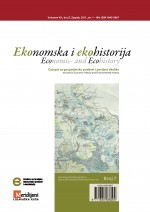The formation of promenades and parks in Zagreb as a part of European cultural heritage
The formation of promenades and parks in Zagreb as a part of European cultural heritage
Author(s): Mirela Slukan-AltićSubject(s): Social Sciences
Published by: Društvo za hrvatsku ekonomsku povijest i ekohistoriju - Izdavačka kuća Meridijani
Keywords: Zagreb; 18 and 19 century; Habsburg Monarchy; urbana povijest; city promenade; public park
Summary/Abstract: As Croatia was a peripheral country of the Habsburg Monarchy, the industrial revolution did not have a significant impact on the urban development of Croatian towns until the second half of the 19th century. Due to the late appearance of industrialisation, the beginnings of the transformation of Zagreb at the time when its urban tissue was stretching out of the medieval walls during the 18th and 19th century, were reflected in the attempt of creating first public green areas. These processes developed under the strong influence of European trends and schools of urbanism whose handy work can be clearly read in all of the projects of the first green areas in Croatian towns and especially Zagreb as the capital of the Croatian and Slavonian Kingdom within the Habsburg Monarchy. This described the intertwining of the European influences as the result of numerous foreign engineers in Croatia as well as the fact that the majority of Zagreb’s urbanism experts, architects and park experts of the time were educated in Vienna, Graz and Munich. In this paper the physical shape, location and social role of Zagreb’s green areas created during the 18th and 19th century will be analysed and the historical contexts of their development will be observed as well as their European prototypes
Journal: Ekonomska i ekohistorija - Časopis za gospodarsku povijest i povijest okoliša
- Issue Year: 2011
- Issue No: 7
- Page Range: 129-136
- Page Count: 8
- Language: English

